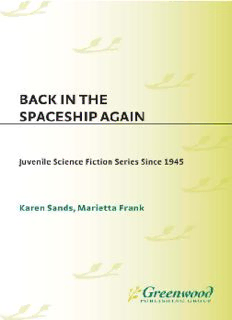
Back in the Spaceship Again: Juvenile Science Fiction Series Since 1945 (Contributions to the Study of Science Fiction and Fantasy) PDF
Preview Back in the Spaceship Again: Juvenile Science Fiction Series Since 1945 (Contributions to the Study of Science Fiction and Fantasy)
Back in the Spaceship Again Recent Titles in Contributions to the Study of Science Fiction and Fantasy Dracula in the Dark: The Dracula Film Adaptations James Craig Holte Offensive Films: Toward an Anthropology of Cinema Vomitif Mikita Brottman Into Darkness Peering: Race and Color in the Fantastic Elisabeth Anne Leonard Trajectories of the Fantastic: Selected Essays from the Fourteenth International Conference on the Fantastic in the Arts Michael A. Morrison, editor Transformations of Language in Modern Dystopias David W. Sisk Folklore and the Fantastic in Twelve Modern Irish Novels Marguerite Quintelli-Neary A Century of Welsh Myth in Children's Literature Donna R. White Strange Constellations: A History of Australian Science Fiction Russell Blackford Immortal Monster: The Mythological Evolution of the Fantastic Beast in Modern Fiction and Film Joseph D. Andriano Young Adult Science Fiction C. W Sullivan 111, editor Spiritual Exploration in the Works of Doris Lessing Phyllis Sternberg Perrakis, editor The Road to Castle Mount: The Science Fiction of Robert Silverberg Edgar L. Chapman Back in the Spaceship Again Juvenile Science Fiction Series Since 1945 Karen Sands and Marietta Frank Contributions to the Study of Science Fiction and Fantasy, Number 84 C. W. Sullivan III, Series Adviser GREENWOOD PRESS Westport, Connecticut • London Library of Congress Cataloging-in-Publication Data Sands, Karen. Back in the spaceship again : juvenile science fiction series since 1945 / Karen Sands and Marietta Frank. p. cm.—(Contributions to the study of science fiction and fantasy, ISSN 0193-6875 ; no. 84) Includes bibliographical references and index. ISBN 0-313-30192-1 (alk. paper) 1. Children's stories, American—Bibliography. 2. Science fiction, American—Bibliography. I. Frank, Marietta. II. Title. III. Series. Z1232.S26 1999 IPS374.S35] 016.813,08762089282—dc21 99-17848 British Library Cataloguing in Publication Data is available. Copyright © 1999 by Karen Sands and Marietta Frank All rights reserved. No portion of this book may be reproduced, by any process or technique, without the express written consent of the publisher Library of Congress Catalog Card Number: 99-17848 ISBN: 0-313-30192-1 ISSN: 0193-6875 First published in 1999 Greenwood Press, 88 Post Road West, Westport, CT 06881 An imprint of Greenwood Publishing Group, Inc. www.greenwood.com Printed in the United States of America The paper used in this book complies with the Permanent Paper Standard issued by the National Information Standards Organization (Z39.48-1984). 10 9 8 7 6 5 4 32 Copyright Acknowledgments The authors and publisher gratefully acknowledge permission for use of the following material: Chapter 4 is reprinted from Karen Sands, "No Business in Space? The Female Presence in Series Science Fiction for Children," Foundation 70 (Spring 1997): 15-24. For Chip, Dennis, Eric, with thanks. K. S. and M. F. This page intentionally left blank Contents Preface xi 1 Introduction 1 2 That Spark of Subversion: Robots, Androids, and Artificial Intelligence 13 3 The Celestial Barnyard: The Familiar and the Strange 23 4 No Business in Space?: The Female Presence 35 5 Science Is Serious Business: The Role of Humor 49 6 But What Is a Superconductor, Anyway?: The Absence and Presence of Science 63 7 The City of Gold and the City of Lead: Utopias and Dystopias 77 8 We Must Learn to Get Along: Aliens and Others 91 9 Juvenile Science Fiction Series and the Coming of Age 101 Appendix: Annotated Bibliography of Juvenile Science Fiction Series 109 Bibliography 131 Index 149 This page intentionally left blank Preface Like a vacationer who returns to a beloved summer house year after year, the ad dicted reader opens book three or four or eleven in a given series and is thoroughly at home in the locale—its now familiar native characters, the verbal shrubbery and the narrative floorboards that occasionally creak. —Lanes, "A Series Is a Series" (128) When browsing the shelves in any bookstore or public library, it becomes ap parent that series books for children account for a large portion of what is available in the fiction section. The existence of series books for children can be traced back to the middle of the nineteenth century, when such series as The Fairchild Family and Elsie Dinsmore appeared. Juvenile science fiction series followed soon after, originating in "the dime novels, penny dreadfuls, and sto- rypapers of late nineteenth- and early twentieth-century America" (Sullivan, Science 1). These eventually gave birth to the Great Marvel and Tom Swift series as well. Much has been written about these early series books for chil dren, particularly the Tom Swift books, but comparatively little has been writ ten specifically about the wide variety of juvenile science fiction series of the second half of this century. To fill this void, this book will take a critical look at juvenile science fiction series since 1945 through their history, themes, set tings, characters, and construction. Identifying series and then locating them turned into a bigger challenge than we anticipated. To begin with, there did not appear to be a bibliography of only juvenile science fiction series. We did locate bibliographies of juvenile series that included science fiction, as well as reference book articles on science fiction that listed some series. We acknowledge the following sources: Young People's Literature in Series: Fiction, by Judith K. Rosenberg and Kenyon C. Rosenberg; Young People's Books in Series: Fiction and Non-Fiction, 1975- 1991 by Judith K. Rosenberg, with the assistance of C. Allen Nichols; and Sci- y
Description: